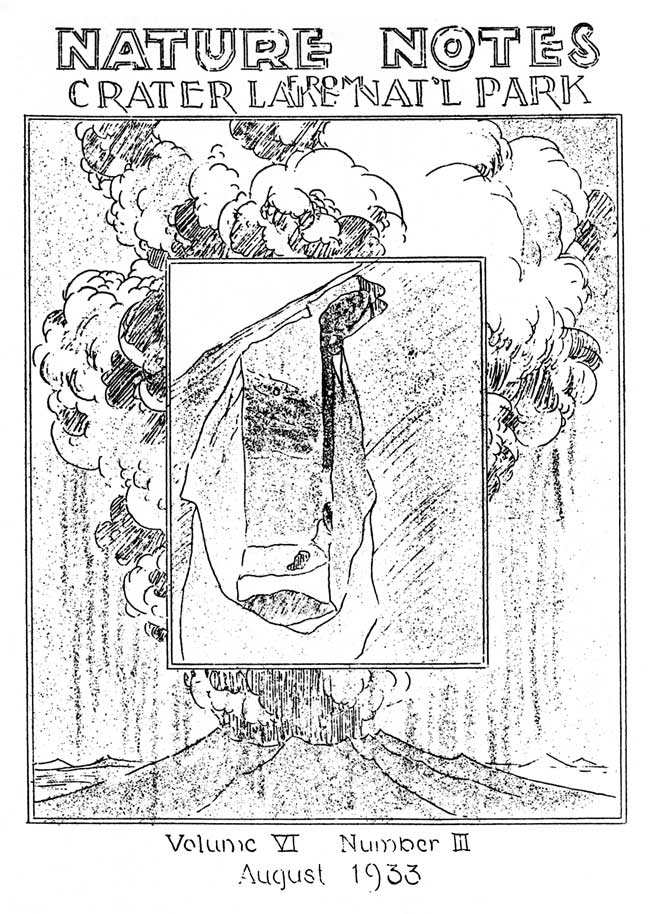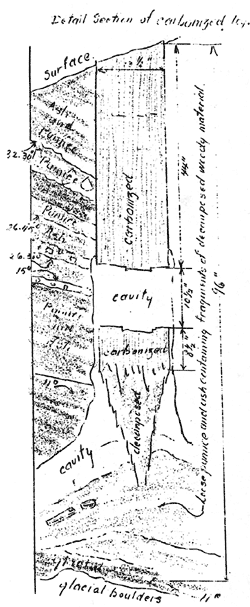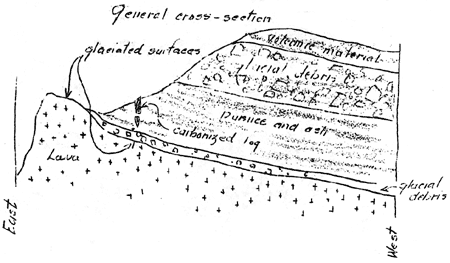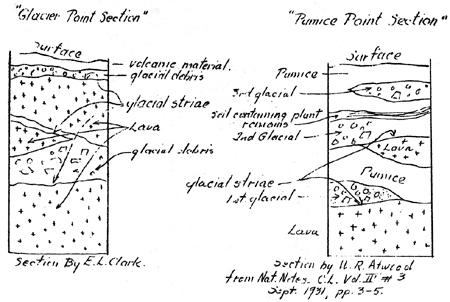Volume 6 No. 3 – August 1, 1933
All material courtesy of the National Park Service. These publications can also be found at http://npshistory.com/
Nature Notes is produced by the National Park Service. © 1933
An Indian Giver
By Ranger R. P. Andrews
(Online Edition Note: Of the hundreds of excellent and informative articles published in Nature Notes, the following article is not one of them. Our apologies for the insenitive nature of this article.)
One hot day some time ago an old model T Ford rattled down the hill from the west and with a wheeze and sigh expired in front of the Annie Springs station. It was a motley menage indeed. The running boards, top, fenders, – in fact every available space was piled high with gear. Wedged into the back seat were two Indian children and an old woman who appeared a hundred years old, at least. But what attracted my attention especially was the driver. He was an Indian of middle age, dirty and unkempt. Such sights are common at Annie Springs and one might be led to wonder why it attracted my attention. However, one who has checked through hundreds of impassive faced Klamaths would indeed be impassive himself were he not startled by that rarest of all Indian facial expressions – a smile. I approached the still steaming remains of what had once been an automobile. Permit book in hand, I inquired his name.
I will not detail the conversation that followed, but I found the driver jovial, friendly, and enthusiastic about the roads and the scenery.
Finally, after obtaining the required information, I tore off the permit and said, “The permit is one dollar”.
He swept an all embracive arm from east to wet. “One time”, he said with regret but no malice, “all this belonged to Indians, Indians hunted, fished, and traveled this country. It was Indian’s land. Then white man came. He cooped Indian up on reservation”. He sighed. “Now white man charges Indian one dollar to travel his own country”.
His words seemed to carry no conviction. He was not in earnest. He seemed to be repeating his tribe’s old, old objection, just to see what I would say. I decided to “kid” him a little.
I assumed a lugubrious expression. “One time Indian had no way to travel. Poor Indian had sore feet”. Here my expression brightened. “Then white man came. Now Indian has no more sore feet. White man took Lake – gave Indian Ford”.
Immediately he chuckled. “OK”, he laughed, handing me the dollar and releasing the hand brake. “You keep Lake – Indian take ’em Ford”. And he rattled off as I stood staring after the strangest of all anomalies – an Irish personality in an Indian body – a smart-cracking Hiawatha.
Carbonized Tree Found Within the Rim
By Park Naturalist D. S. Libbey
One of the most significant discoveries that has been made since Crater Lake has been known to white men was made on August 1. A carbonized tree trunk in upright position was discovered within the rim of Crater Lake by Ranger – Naturalist Albert E. Long while he was assigned to research study. On August 7 Mr. Long in company with the writer uncovered the specimen. A complete photographic record of the find was taken, pictures being taken prior to any excavation, and at the significant stages in the progress of unearthing the specimen. The sketch below indicates the location of the find within the rim of the crater.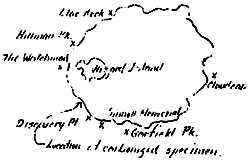
Only a very small portion of the specimen was exposed. The log as unearthed was 13-1/2 inches in diameter at the top and 15-1/2 at the base and stood in an almost upright position, leaning six degrees to the north. The excavation of the find was only partially completed so that only one side of the log was exposed, revealing the positive evidence of the in situ character of the find.
By reference to the accompanying diagram it will be seen that the total length of the log was 52 inches. It is evident that the stump and bole of the tree was the portion found. The lower section, including the huge branching roots, was not carbonized, and large cavities resulted from the disintegration and decomposition of the roots and stump. The entire section was as follows: 44 inches from the top completely carbonized, then a break occurred with a cavity 10-1/2 inches resulting from the slipping of the lower section. The lower portion of the stump and roots decomposed and the cavity resulted.
Below the break 8-1/2 inches of carbonized log was found which graded into the uncarbonized material which progressively became more decomposed until finally the huge open space was found, which resulted from the decomposition of the uncarbonized stump and roots.
The roots now decomposed were originally imbedded in a layer of glacial debris, (mixed rocks, and ash and glacial clays resulting from the breaking down of andesite rocks). This bedded material was dipping at an angle of 11 degrees to the west. The layers on top rest in various attitudes. The layers in sequence from the base up were found to repose at attitudes of 11 degrees, 15 degrees, 26 degrees 15 minutes, 26 degrees 45 minutes, and 30 degrees 30 minutes.
The roots and stump rested on a mass of heterogeneous glacial debris. The bole of the tree just above the glacial imbedded stump and roots was surrounded with pumice and pumicite material which evidently fell and tumbled down the slope after it was cool and hence the lower portion was not carbonized.
The carbonized portion was imbedded in angular pumice fragments interspersed with pumice dust and ash material. The inner facing crest of the rim above the location of this discovery consists of an overburden of slightly sorted glacial debris, intermingled with pumicite.
In 1931 the writer published in Crater Lake Nature Notes (Vol. IV, No. 1) an article titled “Carbonized Wood – An Index to the Past”, which reported the discovery of huge carbonized logs in the excavation along the new Diamond Lake Highway, still under construction. A cross-section of a huge log was obtained by the writer during July, 1931 and was placed in the museum room of the Sinnott Memorial where it now rests. On July 27 of this year in company with Mr. John R. Sargent, Resident Engineer for the Bureau of Public Roads, the writer obtained another cross-section of a carbonized log from the Diamond Lake Highway excavation approximately ten miles above the place where the 1931 specimen was taken. It is planned to place this specimen in the museum room of the Watchman Observation Station with a marker pointing to the place from which the find was taken. The specimen was found just to the east of the Rabbit Ears, 20 miles to the west of the rim of Crater Lake, 25 feet above and 100 yards from the stream course of the Rogue River.
These finds are mentioned since their discovery in situ with an overburden of volcanic pumice, dust and ash resting over the logs to a depth of 60 feet, points to the fact that the logs were covered by the explosive volcanic material so thickly and so fast that air was excluded and the hot material caused carbonization without combustion. The recent find of August 1 by Ranger-Naturalist Long establishes the fact that a similar action occurred on the outer slope of the old volcanic cone.
Conclusions
The location of a carbonized log within the existing crater slope, with a stump and roots uncarbonized and partially decomposed, presents many problems of great importance. It is quite evident that the attrition or wearing of the inner rim slope has shifted the crest of the rim outward and that at the time of entombment the tree was growing on the radiating slope of old Mt. Mazama. The tree was growing on a glaciated surface covered with glacial debris. Cool pumice and pumicite tumbled down the slope above to cover the roots and base of the tree, and then at a subsequent time hot volcanic ejecta, pumice, and ash settled around the tree so fast that air was excluded, combustion was prevented, and carbonization resulted. Subsequent glaciation ground down the sloping surface of the pumice, ash, and dust which had covered and carbonized the tree. The erosion at the rim slope has shifted outward so that now the specimen is located within the existing crest of the crater rim.
The wood of the roots and base of the tree trunk at the present time being only partially decomposed presents an implication that the explosive activity of Mt. Mazama was more recent than previously estimated. The presence of the upper glacial deposit establishes the fact that the entombment of this specimen was made prior to the destruction of the old volcanic cone since the higher elevations of the mountain necessarily existed in order to have a glacier form. The resulting distribution of glacial debris is one of the topmost coverings of the rim crest post-dates the final volcanic activity.
The similar conditions on entombment, carbonization of logs, and excessive depth of volcanic debris in the Diamond Lake Highway excavation postulates the tremendous amount of eruptive material distributed by explosive action of the volcano. It appears reasonable to assume that explosive action was the major force involved in the destruction of the upper portion of the volcanic cone, although it is possible subsidence, sapping, and undermining may have contributed an appreciable pat of the enlargement of the original crater.
Three Successive Records of Glaciation
By Ranger-Naturalist E. L. Clark
Along the inner rim slope midway between Sinnott Memorial and Discovery Point occurs a record of three successive glaciations. There in the great outdoor laboratory of vulcanism and glaciation are found three separate layers of glacial drift. The accompanying diagram illustrates the arrangement of the several glacier evidences. A section by W. R. Atwood has been included as a means of comparing the evidence of glaciation found at different localities within the rim of the crater.
It will be readily seen that the record of glaciation found at “Glacier Point” is of much significance inasmuch as it represents two distinct outpourings of lava after the appearance of the first glacier. The question may be raised; Are the glacial tracks really the marks made by moving masses of ice or are they pseudo-glacial markings formed by the solidification of hot, seething masses of lava pouring out of a volcanic crater and down the mountain side?
Glacial striae are superficial scratches or grooves made on a rock surface by the tools of a glacier as it slides over the bedrock. These markings are usually arranged in parallel groups. The direction in which the striae are running is indicative of the general trend of movement of the glacier at that particular place. It happens that the rock surfaces will be somewhat polished and at least smoothed by the abrasive action of the ice and detritional rock fragments.
Banding due to flowage of the lava is the internal arrangement of particles within the lava flow. These particles may occur singly or in combination.
They may be crystals that had started to form before the ejection or outpouring of the lava from its conduit. They may be included material that were picked up by the lava as it moved over loose fragments of other rocks; or they may happen to be certain portions of the lava flow rich in volatile constituents which on release may leave cavities in the solidified lava and produce the frequent occurrence of lines or layers of bubble marks in a lava. One portion of this structure may vary in its relation to its remainder. Furthermore, one set of flow banding need not agree in attitude with the other sets of flow banding in a single lava bed. More often it happens that one flow structure can be traced to a place in the lava flow where it intersects a second flow banding. Fracturing of the lava during its cooling may produce smooth curved surfaces, but these will never be straight and polished as produced by glacial scour.
One who walks along the path of Nature to Discovery Point shall have a wonderful opportunity to read the story recorded in the rocks and distinguish between these confusing structures. Along this trail one first meets with glacial striae on the upper surfaces of many lava flows. Next a pseudo-striation produced by both flow banding and fracturing of the hot molten mass will be noted. And further along the trail Mother Nature has placed these two confusing structures together. The glacial striae are seen to be at right angles to the flow banding of the lava, and again, within the same lava flow, the striae are seen parallel to the banding. Truly, it is here where Mother Nature has solved the problem and completed the lesson for the day.
Fireside Meanders
By Chief Ranger D. H. Canfield
Gently stroke a marmot on the back — he flattens out like a fur rug — but be sure he gets the idea before you start the petting — those sharp teeth might cause sad retrospection; influx of visitors well underway — boy, place those garbage cans more conspicuously; “strength in numbers” found fallacious in E. C. W. boys’ football game with 17 on one side, 10 on the other — referee outmoded: — O lady! Those flowers don’t like to leave their homes — naughty, naughty — mustn’t pick; rainbow spawning in the lake — two to three months later than in water of ordinary temperature; tiny bear cub shinnying up a man’s leg with Mamma Bear unpreturbed — generally that man would be flirting with disaster; digging through five feet of snow to erect ranger-naturalists’ tents at the lake rim — no requests received from them for ice boxes; rangers enthusiastically aid scientist in quest of fleas from wild animals — interpretation left to reader; boulder from rim wall catapults into beached rowboat — matches no longer needed for toothpicks; 21 foot layer of snow at foot of lake trail a 6-5 favorite to last the summer; motorist demanding his permit dollar back — evening climate termed too frigid; 73′ 3″ of snowfall covers a lot of sins during the winter – but they come to light again with the melting; no two sagebrusher parties ever want the fireplace in quite the same place; E. C. W. boys — from the mid-west evince tremendous interest in the same mountain and forest work methods and lore; meanderings such as this call forth the catty remark to a poor driver — “Drive it or park it.” Let’s park it!
Nature Notes
By Ranger Milton E. Coe
One of the most interesting and at the same time the easiest trips in the Park is the walk to Discovery Point. Here one sees the Lake in an every changing setting. Time and all subsequent agencies has played a part in eroding the crater wall. It is just beyond this point that the discovery was made of the carbonized log within the inner slope of the crater rim. The story of the past and a prophecy of the future is here written as clearly as though in print.
Trees, no doubt, once firmly rooted in firm rocks and soil are now hanging on by roots on one side only. Others twisted, gnarled, and broken give evidence of the winter’s blast. Again a small sapling growing near the brink will, without doubt, never reach maturity.
Rock ledges cracked and broken are adding their bit to talus slope and large boulders hanging in the balance are ready to crash downward to destroy a tree that even dares to grow.
Truly a battle is being waged and all the forces of nature have taken sides.
Other pages in this section


